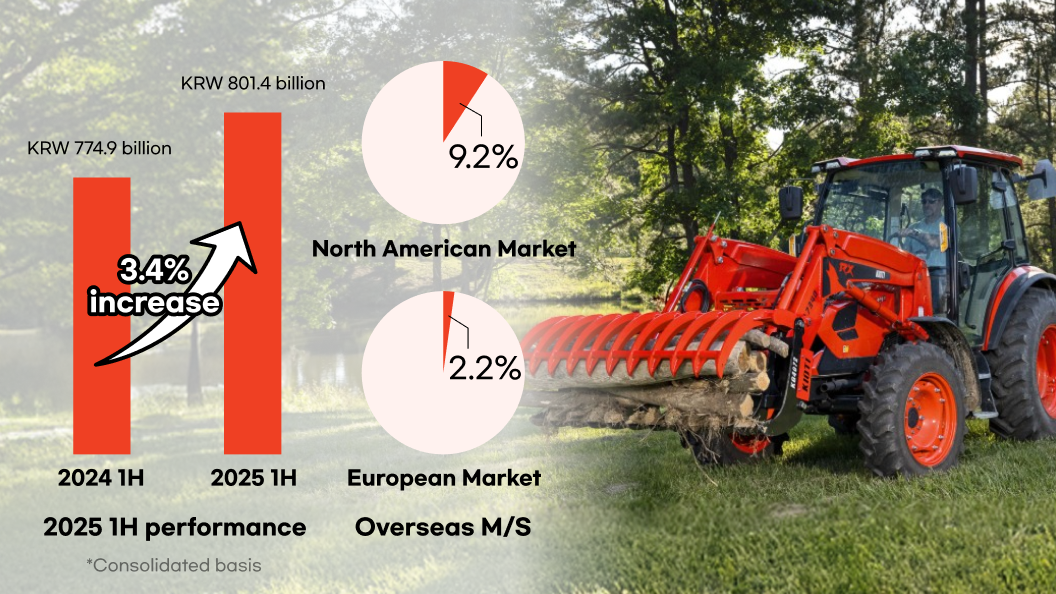Daedong Reports KRW 801.4 Billion in Sales for H1 2025, Accelerating Growth through Streamlined Pre-Order System
Daedong Reports KRW 801.4 Billion in Sales for H1 2025, Accelerating Growth through Streamlined Pre-Order System
- Strengthened market presence despite global slowdown... H1 market share in North America and Europe rose to 9.2% and 2.2% year-on-year
- Established a global pre-order framework, ensuring stable sales volume and production efficiency... secured early third-quarter orders in North America
- Further growth momentum expected from expansion of parts and service operations and entry into Europe’s CCE market
- Exploring new business opportunities through agricultural reconstruction in Ukraine to enhance mid- to long-term profitability
Daedong (Co-CEOs: Kim Jun-sik and Won Yu-hyun), a leading company in future agriculture, announced on August 14 that it achieved consolidated sales of KRW 801.4 billion in the first half of 2025, up 3.4% year-on-year. Operating profit came to KRW 46.8 billion, a 1.7% decrease compared with the same period last year. The solid performance was driven by continued growth in the North American and European markets. By region, sales from the North American and European subsidiaries rose by 10% and 25% year-on-year, respectively.
Despite a challenging external environment marked by an overall slowdown in the global agricultural machinery market, particularly in North America and Europe, Daedong achieved steady performance through strategic market responses and the continued advancement of its products, parts, and service operations. In North America, the company reorganized its business into five regions, including Canada, beginning last year. Based on detailed market analysis in each region, Daedong has been implementing targeted strategies.
This approach helped the company raise its share of the sub-100 horsepower tractor market to 9.2% in the first half, up 1.3%p year-on-year (according to AEM), further solidifying its position in the market. Looking ahead, Daedong expects the positive impact of several initiatives launched in North America earlier this year, including price adjustments, the opening of a West Coast warehouse, the expansion of its Connect app user base, and the growth of its dealer network, to begin materializing in the second half.
H1 2025 Results: Sales Up 3.4% Year-on-Year, Market Share Reaches 9.2% in North America and 2.2% in Europe

Drawing on market insights, Daedong has strengthened its global pre-order program for dealers. This initiative helps reduce seasonal fluctuations in sales and enhances both commercial performance and production efficiency. In North America, Daedong secured its third-quarter supply volume in advance through dealer pre-orders. The company also responded quickly to higher US tariffs by adjusting pricing and sales strategies, and it is aiming to sustain growth throughout the second half.
The European market is also maintaining positive momentum. As of the first half of the year, Daedong’s market share in Europe reached 2.2%, up 0.4%p from the same period last year. This growth was driven largely by strong sales increases in Southern and Eastern Europe. In Southern Europe, sales rose by 46% in Spain and 132% in Italy, led by the RX and HX models. In Eastern Europe, growth was fueled by expanded sales through a new distributor in Poland and a 70% increase in Slovenia.
Starting in the third quarter, Daedong will launch its new DK series tractors targeting the European orchard farming market. The company will also begin introducing skid loaders, marking its expanded entry into Europe’s compact construction equipment sector. At the same time, Daedong will expand and relocate its existing warehouses in the Netherlands and Germany. These efforts are aimed at strengthening the company’s sales and distribution competitiveness across the European market.
Daedong is also identifying new business opportunities through the reconstruction of Ukraine’s agricultural sector. In July, the company signed an MOU with the Ministry of Agrarian Policy and Food of Ukraine to provide training and technical support for agricultural machinery, securing an official channel of cooperation for the country’s post-war recovery. This partnership is the only central government-level agreement established by a Korean agricultural machinery manufacturer. Based on this collaboration, Daedong intends to expand its involvement in government-led initiatives and project contracts. The company also plans to position Ukraine as a strategic hub for its Eastern European expansion, with the goal of enhancing profitability over the mid to long term. In addition, under a three-year supply agreement valued at KRW 30 billion that was signed with a local distributor in November 2024, Daedong began shipping mid- and large-sized tractors in January of this year. The company expects to steadily increase annual delivery volumes over the course of the contract.
Meanwhile, Daedong is enhancing its parts and service business as well. In the first half of the year, the company earned strong recognition from local customers in Europe by introducing a seven-year free warranty program across all tractor models, the first initiative of its kind in the market. In July, Daedong also launched an extended warranty product in North America, aimed at improving customer satisfaction while diversifying its revenue streams. Looking ahead to the fourth quarter, the company plans to expand accessibility and distribution efficiency by beginning parts sales through Amazon. It will also raise the parts supply rate at its overseas subsidiaries to 95%, further strengthening its ability to respond quickly to market needs.
In its home market, Daedong is focusing on consolidating its leadership in advanced agricultural machinery. In August, the company will release a new combine harvester - the first in Korea to feature both a yield monitoring function and Level 3 autonomous driving - to meet the surge in demand during the autumn harvest season. Daedong is also stepping up sales promotions for its autonomous transport robot, which was launched in July, while exploring applications beyond agriculture to broaden its reach across a variety of industries
